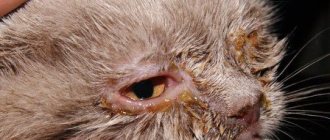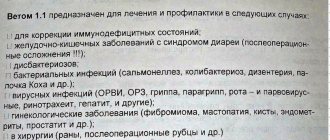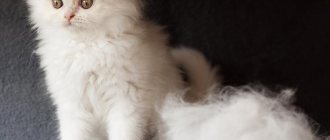7549Administration
If white worms appear in a cat's feces, this indicates the appearance of tapeworms in the animal's body. This is a fairly common occurrence, especially if the pet is free to roam outdoors. The danger of tapeworms lies in the fact that they cause mechanical damage to organ tissues, as a result of which the vessels are destroyed and the tissues begin to die. Cats that do not go outside can also become infected with worms by eating raw fish or meat or drinking dirty water. Often, owners accidentally bring helminth larvae from the street.
Types of helminthiases
- roundworms – nematodes;
- flatworms – trematodes and flukes;
- ribbon type.
One of the types of worms that can be found in cats are roundworms.
Cat infection leads to problems with bowel movements
Before ridding your cat of worms, you should carefully consider the main symptoms:
- the appearance of digestive system disorders, the main symptom will be the alternation of loose stools with constipation;
- the occurrence of attacks of nausea, sometimes with vomiting, vomiting with blood or worms may occur;
- parts or whole worms may be present in the animal’s feces or in the anal area;
- impurities of blood and mucus may be present in the stool structure;
- the appearance of an itching sensation in the anus - usually when this symptom is present, animals begin to periodically rub themselves on the floor, this will be a sign that the animal is sick;
- bloating;
- problems with appetite;
- there is heavy breathing with cough;
- the kitten experiences a slowdown in growth and development;
As a result of infection, your pet's appetite is impaired.
- the appearance of yellowness of the mucous membranes and eye sclera;
- There is often an accumulation of mucus in the eyes;
- if timely treatment is not provided, paralysis of the hind limbs occurs;
- Premature lambing occurs in pregnant cats.
Visually it can be detected in the feces, in the anal area in the form of segments that externally resemble cucumber seeds up to 8 mm in size.
Tapeworms have their own special structure
What worms can cats get?
Roundworms
In most cases, cats are diagnosed with infection with nematodes such as hookworms and toxocaras.
- Hookworms are small worms up to 1 cm in size. They feed on the host’s blood, leading to anemia and making many wounds in the intestinal walls with sharp teeth. Several dozen of these helminths can lead to the death of a small cat in a matter of days;
- Toxocaras are the causative agents of toxocariasis, white, thin worms reaching a maximum length of 20 cm. They take away useful substances from the cat, causing vitamin deficiency and exhaustion. With severe invasion, they can completely block the intestinal lumen. In young animals whose intestines are too small for such parasites, the intestines may rupture.
Tapeworms (cestodes)
Cestodes are long flatworms, the length of which can reach up to 70 cm. The bodies of cestodes consist of numerous segments, each producing larvae. Tapeworms parasitize the walls of the small intestine.
Detection of diseases caused by tapeworms is much easier, since segments that secrete helminths can often be found near the anus.
- The causative agent of alveococcosis is alveococcus . Small worms, their length does not exceed 1-4 millimeters. They parasitize the intestines.
- Cucumber tapeworms , which cause dipylidia, reach 20-30 cm in length. They parasitize the intestines.
Flatworms (flukes)
Flatworms in cats are quite rare. Trematodes are often called flukes due to the suckers that are located on their bodies.
Trematodes are white thread-like worms that attach to the intestinal walls using suction cups, causing mechanical damage to the mucous membrane and also have a toxic effect.
Trematodes are much less common than the two previous types of helminths, but it is worms of this species that pose a mortal danger to cats, as they are capable of destroying internal organs and tissues. They parasitize not only the intestines, but also the liver, bladder, and lungs.
- The pulmonary fluke causes paragonimiasis. It reaches 0.3-1 cm in length. It parasitizes the animal’s lungs, forming cysts and destroying lung cells.
- The liver fluke (cat fluke) up to 5 mm long causes opisthorchiasis - a dangerous disease that affects the liver and gall bladder.
Treatment
Pills
There are drugs in tablet form that are used once
. You can give the medicine forcibly by placing the tablet on the root of the tongue, or crush it and mix it with water and pour it into the mouth using a syringe. During the treatment process, it is important to ensure that the pet does not spit out the medicine. The most popular medications to help control tapeworms in cats are:
Drops on the withers
This form of anthelmintic drugs is convenient when the animal refuses to take the medicine orally. Drops are applied to the occipital region once. Effective:
Drops are applied to the occipital region once. Having parted the animal's fur, squeeze the contents of the pipette onto the skin in accordance with the recommended dosage. Manipulation should be carried out carefully so that the medicine does not get on your hands.
Suspensions
The medicine has a sweetish taste. Injected into the oral cavity using a syringe. The following drugs have found widespread use:
The advantage of drugs in the form of a suspension is the inability of the animal to remove the injected drug from the mouth.
Sugar cubes
Polyvercan is available in the form of sugar cubes
Polyvercan, produced in the form of a sugar cube, has an unusual shape. It interferes with the absorption of glucose by the parasite, which leads to metabolic disturbances and death of the worm. The cubes are given to the cat as a treat, dissolved in a small amount of water or added to cat food.
Helminthiasis, or in common parlance worms, is an unpleasant disease of both animals and humans. If you have a cat in your apartment, then there is a chance that it can become infected with worms. Worms bring a lot of trouble to a cat, usually itching in the anus, abdominal pain, vomiting, and diarrhea. What do worms look like in cats? Adult worms can at least be seen with the naked eye. Cats are affected by flat and round worms.
It is recommended to drive helminths twice with an interval of 2 weeks. As an anthelmintic drug, it is important to choose a broad-spectrum medicine, for example Kanikquantel. Of course, first it is better to consult a specialist, since all such drugs are poisons, and the cat may have a hard time withstanding the treatment. At the very least, the dosage must be calculated taking into account the age and weight of the animal.
Video about treatment of worms in cats
What to do if the owner suspects worms in his pet? At the first sign of worms in cats, you should contact your veterinarian. Since infestation indicates that there are many parasites in the pet’s body. It is not recommended to treat your pet with medications at home.
List of drugs
Usually the veterinarian prescribes:
- Pirantel. This is a mild remedy against roundworms. It does not kill the parasites inside the cat, and only immobilizes them. Thus, it does not lead to intoxication of the body and is safe. Worms can be found in your pet's feces after defecation.
- The drugs praziquantel, fenasal, and phenalidone are effective against infection with flatworms.
- If you treat roundworms with detrazine or fembendazole, you can quickly achieve the desired result.
- Praziquantel helps kill the fluke that attacks the lungs.
- Milbemax is effective against roundworms.
- Complex treatment under the supervision of a veterinarian is necessary if the animal is infected with opisthorchiasis, which affects the liver.
- Medicines should be given to the cat in the morning before meals.
- It is necessary to strictly observe the dosage of the drug.
- Sometimes, as prescribed by the veterinarian, before giving the cat medicine it is necessary to cleanse the intestines.
- Medicines in tablet form should be crushed and placed on the root of the tongue. Thus, the pet will be forced to swallow it.
- It is quite effective to add medications to food.
- If an animal behaves aggressively, it must first be restrained so that it does not injure itself.
After 14 days, the cat needs to be given the medicine prescribed by the veterinarian again.
Treatment and prevention of helminthic diseases are carried out with the same drugs, or rather, active ingredients
The only difference is that when treating long-term helminthic infestations, additional precautions or therapy may be required. The composition of all drugs for worms is similar and usually includes two active ingredients
Substances that eliminate roundworms:
- Piperazine.
- Pirantel.
- Milbemycin.
- Fenbendazole.
If drugs are used for prophylaxis, the application algorithm is as follows:
and - given in the morning on an empty stomach, on the root of the tongue. If you cannot give your cat the medicine, it can be mixed with a small amount of food. The tablets are pre-crushed into powder.
applied to the withers or back of the head at any time convenient for you. Until the drops are completely absorbed (usually 2-4 hours), you need to monitor your pet so that he does not lick the drug or use an Elizabethan collar.
This is what some cat worms look like
If your cat has frequently recurring bloody or watery diarrhea, it is best to do a stool test to make sure there are no helminths in her body and, if so, what kind. Signs of helminthiasis may also include a bloated abdomen, emaciation, vomiting or constipation, and lethargy. White-pink worms are sometimes visible in the stool. What do worms look like in cats? They can be flat or round. Let's look at the most common helminths.
Adults, clogging the intestinal lumen, can cause intestinal obstruction. Cats often become infected with Toxocara by eating rodents. The high incidence of these worms in kittens is explained by the fact that transmission is possible from a sick mother through the placenta and milk. In the acute course of the disease, kittens may experience vomiting, fever, alternating constipation and diarrhea.
Cat flukes - opisthorchis (length up to 1 cm) live in the bile ducts and pancreatic ducts. Cats become infected by eating raw fish.
The cucumber tapeworm is a slightly pink flatworm that lives in the small intestines of a cat and looks the most terrifying: its length reaches one meter.
And finally, the tapeworm is wide, reaching one and a half meters long in a cat, and 15 meters in a person (it’s scary to even imagine). Cats become infected by eating raw fish. Of course, the review of helminths is not presented in full. There are other species that can be detected and identified in a veterinary hospital.
Other parasitic worms in cats
Tapeworms are just one of the common types of parasitic worms that infect animals. International Cat Care identifies several other types of parasitic worms found in animals:
- Roundworms. Most often found in cats. Kittens become infected with them through their mother's milk. An adult animal becomes infected by eating an infected rodent.
- Nematodes. Most common in dogs, but also found in cats. They are small and, like tapeworms, live in the small intestine of an animal. They feed on animal blood, which can lead to anemia. Infection occurs when the eggs or larvae of nematodes are ingested.
- Non-intestinal worms. Pulmonary, cardiac and ophthalmic, living in the corresponding parts of the animal’s body.
Talking about parasitic worms living in an animal's body can make owners feel nauseous even with the strongest stomachs. Luckily, even though they are large, parasitic worms are fairly easy to get rid of and there are no long-term health consequences for your pet. The best thing you can do for your cat is to closely monitor its behavior. Sudden changes in her behavior may indicate health problems. This is why regular veterinary examinations are so important.
Treatment options
What should I do if I have white worms in my stool? Treatment of infection with tapeworms is carried out using only a few anthelmintic drugs; the choice, unfortunately, is small:
In addition to the course of these medications, people must observe the rules of personal hygiene, since tablets cannot completely destroy parasite eggs, thereby increasing the likelihood of re-infection.
Many people who suffer from parasites lean toward traditional methods of treatment and alternative medicine. However, it should be remembered that natural treatments can be effective, but also dangerous for the patient’s health. In addition, treatment with traditional medicine will take much longer.
Sometimes doctors themselves recommend the use of various medicinal plants, but only as an addition to the main course of therapy. For example, carrot and beet juice helps very well; the products relieve intoxication in the body, which is caused by the vital activity of parasites.
In the house where the patient lives, it is necessary to carry out wet cleaning with warm water and soap. Carpets and soft toys are treated outside and not brought into the house until the patient recovers. If any items cannot be washed, it is better to get rid of them.
The danger of white worms appearing in a cat's feces
All types of tapeworms are dangerous because they mechanically affect the tissues of internal organs, thereby causing serious damage, leading to necrosis and destruction of blood vessels.
All types of tapeworms are dangerous.
Worms are able to feed on lymph and blood, which leads to serious pathologies . The waste products of microorganisms release toxins that poison the body and cause intoxication and allergic reactions. Intestinal blockage may also occur and without timely surgical intervention the animal will die.
- The presence of cestodes is manifested by atypical behavior of the cat, its aggression and irritability. The feces contain white speckles, similar to grains of rice.
- Tapeworms can provoke serious diseases, such as: diphyllobothriasis, alveococcosis, dipylidiasis, opisthorchiasis, paragonimosis.
- Diphyllobothriasis is characterized by the appearance of bloody vomiting, dull hair, progressive diarrhea, loss of appetite, apathy and weakness.
- Alveococcosis is usually asymptomatic, so it is difficult to diagnose and it is often too late for the animal to come to the rescue.
- The development of opisthorchiasis causes damage to the pancreas and gall bladder. It is expressed by pain in the abdominal area, yellow vomiting, decreased appetite, diarrhea, and fever.
- Paragonimiasis affects the functioning of the respiratory system, in particular it destroys lung tissue and forms cysts. There is an increase in temperature, vomiting with foam, diarrhea, and cough.










